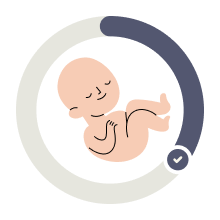As you reach 22 weeks of pregnancy, there are several interesting updates to look forward to.
This period is often considered the “honeymoon phase” of the second trimester, with the unpleasant first trimester symptoms like nausea and vomiting now in the past.
You may still have a few more weeks until you start experiencing the aches and pains associated with carrying a growing baby. By now, you have likely already had your anatomy scan, but if you could catch a glimpse of your developing baby, you would notice some exciting changes this week.
Pregnancy Week 22 Quick Facts
- At 22 weeks, you’re five months pregnant
- You have 18 weeks until your due time “Calculate due date”
- You’re in your second trimester
Your Unborn Baby’s Size at 22 Weeks
How Big is Baby?
At 22 weeks, your baby is about 27.8 centimeters (10.94 inches) and weighs around 430 grams (15.17 ounces). That’s like the size of a papaya!
Pregnancy Symptoms Week 22
Acne
- Pregnancy acne is a frequent occurrence, even for those who have never experienced pimples before.
- Before using any acne medication, it’s important to consult with your healthcare provider or a dermatologist to ensure its safety for use during pregnancy.
- To learn more about safe skincare practices during pregnancy, seek guidance from your healthcare provider.
Spider veins
- Spider veins, much like varicose veins, often make an appearance during pregnancy due to the extra blood and increased pressure on veins caused by a growing uterus.
- To prevent the onset of spider veins and varicose veins, it’s recommended to engage in regular physical activity, elevate your feet, avoid prolonged periods of sitting or standing without a break, and wear compression socks.
Constipation
- While constipation is more common than diarrhea during pregnancy, it can still occur for many of the same reasons as when you’re not pregnant.
- In late pregnancy, some women report experiencing mild diarrhea just before going into labor.
- If diarrhea persists for more than two days or you suspect food poisoning, it’s crucial to contact your doctor or midwife.
Swelling
- Pregnancy swelling, also known as edema, is a normal occurrence.
- While swelling is common, it’s important to watch for signs of preeclampsia, such as excessive or sudden swelling of your feet or ankles, or more than moderate swelling of your hands or face.
- Additionally, if one leg is significantly more swollen than the other, it may indicate a blood clot called DVT (deep vein thrombosis), and it’s essential to notify your healthcare provider immediately.
leg cramps
- During your second trimester, you may experience leg cramps, especially at night while sleeping.
- Leg cramps may be due to the additional weight your body is carrying or related to pregnancy swelling.
- When you experience a leg cramp, promptly stretch your calf muscles by straightening your leg and flexing your toes back towards your shin.
Pelvic pain
- Pelvic pain is a common occurrence during pregnancy due to the normal changes in your body such as weight gain, relaxed ligaments, and a shifting center of gravity.
- This can lead to lower back pain and pelvic pain that may feel like soreness, stabbing, stinging, or burning sensations in the front or back of your hip bones.
- To ease the discomfort, consider using a pregnancy belly band or support belt, physical therapy, or taking acetaminophen after consulting with your provider.
Prenatal Tests and Doctor’s Appointments
If you have a prenatal testing appointment scheduled, it’s important to note that this week is often the final week to complete certain tests, which may include:
- The maternal serum screening or quad screen blood test, which is typically administered between 15 to 22 weeks of pregnancy.
- The Level 2 ultrasound, which is typically conducted between 18 to 22 weeks of pregnancy. (Refer Level-2 Scan)
- In the event that a fetal echocardiogram is required, it typically occurs between 18 to 22 weeks of pregnancy.
Developmental Milestones
Your baby’s hair
Your little one’s head is adorned with fine, delicate baby hair, which may thicken and become more lustrous over the course of pregnancy. Additionally, your baby now boasts eyebrows and soft, fine lanugo hair on their back, ears, shoulders, and forehead.
Hearing your heartbeat
As your baby’s hearing develops, they may start to perceive sounds emanating from your body, including your breathing, heartbeat, and digestion. These internal noises will gradually become more audible. After birth, your baby may find comfort in a sound machine that produces whooshing and thumping sounds similar to those they heard in the womb, which may help them sleep better.
Baby fat
Beneath your baby’s skin, a layer of fat is forming. While you may look forward to kissing their chubby rolls in the future, for now, their body is still quite slender.
Making Strong Bones
As your baby grows at a rapid pace, they require an increased intake of calcium to support their healthy development, particularly for the growth and strengthening of their bones and teeth. Their skeleton is continuously becoming sturdier.
Movements
At this stage of development, your little one’s hands have become more dexterous and can move independently. They are able to touch one hand with the other, cross their hands, and even grasp onto their umbilical cord.




